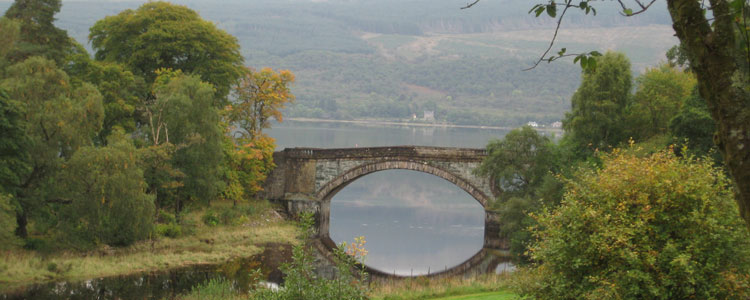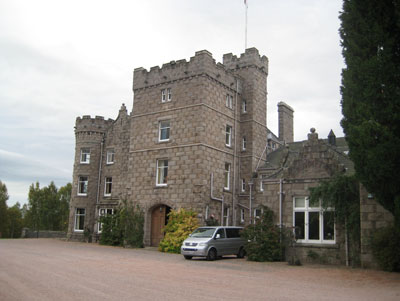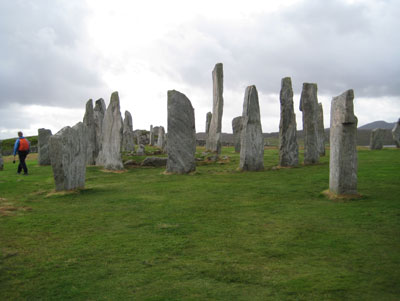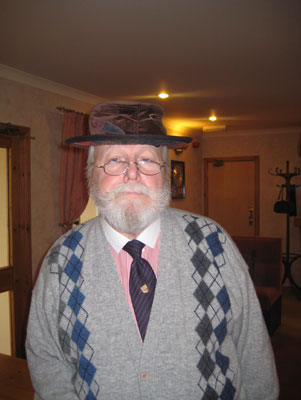The Road to the Isles—A driving tour of Scotland
by Barbara Glavish; Incline Village, NV
“Sure, by Tummel and Loch Rannoch and Lochaber I will go…” and, as in the traditional Scottish song, I did. But I didn’t walk by heather tracks, nor did I have a cromack. What I did have was a luxurious minivan from Midway Motor Travel, a very knowledgeable driver/guide with an irrepressible sense of humor, and five delightful traveling companions who, like myself, were “women of a certain age.”
Getting there
My “road to the isles” began Sept. 6, 2009, with a relaxing dinner and a good sleep on my Air New Zealand flight from Los Angeles to Heathrow. I stayed overnight near London’s Euston Station, whence I headed north to Glasgow along the west coast with Virgin Trains (phone +08719 774 222, www.virgintrains.co.uk). This trip is considered by many to be one of the most scenic in the world.
A fare of $240 covered not only a recliner seat with a table but three hot meals, a variety of snacks and as much wine, spirits, tea and coffee as one could wish for during the 5½-hour journey.
After a day spent at Glasgow’s wonderful Kelvingrove Art Gallery & Museum, I left the city by train and headed for Oban. From there I took the ferry to the Isle of Mull, my first landfall on the isles of western Scotland.
The huge car ferry took less than an hour to get to Craignure, the main ferry terminal on the island, and then it was a half-hour bus ride to the town of Tobermory. The brightly painted facades of the buildings along the waterfront there were originally decorated for a TV series, but they were such a hit with tourists that they’ve been kept up.
The Tobermory Hotel looks out across the sound, but my room was located upstairs at the back. My room was comfortable but compact — and it had the first of many signs I saw on this trip urging one to keep the bathroom door closed while showering so the smoke alarm didn’t go off from the steam!
Don’t miss the gourmet dinner at the hotel restaurant, but book well in advance as they are always busy. Meal prices range from about $40 for two courses to $50 for four courses.
Island exploration
I had arranged via the Internet two all-day hikes with Ruth Fleming of Mull Magic (Argyll, Scotland; phone +01688301213, www.mullmagic.com). Ruth not only knows the geography of the island but is well acquainted with its flora, fauna and history and is a great bird spotter. (We saw sea eagles!) On both days, I enjoyed the serenity, the views and the abundant bird life and gained a better understanding of the island and the people who call it home.
At the southernmost end of Mull, a short ferry ride took me to the island of Iona, where St. Columba established a monastery in 563. The present Benedictine abbey was built in 1203, and gravestones in the adjacent cemetery offered a glimpse of what must have been a difficult and isolated way of life.
From Iona it is only a short boat ride to the Isle of Staffa, the legendary home of Fingal the Giant, and Fingal’s Cave, but the sea was a bit rough, so I didn’t make the trip.
Joining the group
I returned to Glasgow, where I was to meet the Midway Motor Travel group. A year earlier I’d taken a wonderful tour with this company to visit some of the magnificent gardens of southwest England. On this tour we were to have the same driver/guide — who not only maneuvered the minivan along narrow lanes and through tiny village streets with skill and aplomb but knew all the best places to visit, eat, shop and sightsee along with the history and folklore of the places we visited — so I was sure I’d not be disappointed this time either.
Before we set off, however, the five of us who had paid for the trip sometime previously each received an envelope containing £150 ($230) in cash. This was because at the last moment a sixth traveler had joined our group, so the cost was less. How honest is that?!
Lots of Lochs
We headed north out of Glasgow along the western shore of Loch Lomond to Tarbet, continuing west through Glen Coe and then south along the shores of Loch Fyne before heading north again toward Oban, Glen Coe and Fort William.
On the way, we stopped at Inveraray Castle, home of the Duke of Argyll, nestled on the banks of Loch Fyne. It is a popular tourist attraction, and this tourist particularly enjoyed the portraits, miniatures and artifacts displayed there.
Fort William is known for its prize-winning Crannog seafood restaurant (phone 01397 705589), located on the harbor. Of course, we had to try the house specialty of Cullen Skink, a cream-based soup of haddock and potatoes. Prices for main courses here range from $23 to $30.
Although the restaurant is a little cramped and quite noisy, it’s well worth a visit. Call ahead, as reservations are difficult to get.
At The Distillery Guest House on the banks of the River Nevis we received our first night of true Highland hospitality, and after a hearty breakfast we headed over to the train station for the two-hour steam train trip to Mallaig. From there we boarded the ferry for Armadale on the Isle of Skye.
After returning to the mainland, we drove around Loch Duich to Eilean Donan Castle, familiar to anyone who watches BBC America. The castle is very interesting, but the best part, for me at least, was the kitchen area, which was set up as if in preparation for a banquet. The model butler, hostess and maids were very lifelike, and the food looked so deliciously realistic that I had to resist the urge to stir the soup or sample a little pie.
After a short detour to Plockton, a lovely little village on the Inner Sound, we traveled back over the Skye Bridge on our way to the Portree Hotel, our home for the next three days. Portree is the main town on Skye.
Island hopping
The Isle of Skye, well known from song and verse, is quite delightful, with many attractions and stunning scenery. The potato famine of 1846 and the infamous land clearances saw many of its people leave, and even today the island has a population of only about 10,000.
Dunvegan Castle, on the northwest coast, is the seat of the MacLeod clan and is well worth a visit, especially for its extensive gardens. Allow plenty of time and take an umbrella!
A two-hour ferry ride from Uig, at the north end of Skye, took us to Tarbert on the Isle of Harris, one of the Outer Hebrides islands. Harris is sparsely populated and reminded me of a gigantic rock garden, although a drive around it showed us some lovely white, sandy beaches.
The island is famous for its Harris tweed, but nowadays much of that textile is made on the Isle of Lewis, our next destination.
The history and culture of Lewis go back thousands of years. Local people still cut peat, and on cold days (which is rather often!) the distinctive smell of peat fires drifts in the air.
Stornoway is the main town of the island, with a population of about 6,000. Most of the people live in and around Stornoway, though a few small rural hamlets hug the coastline. The interior of the island is fairly bleak moorland, but the west coast has some pretty beaches.
Our lodging for the next three nights was just outside Stornoway at Braighe House, where the proprietors offered us warm, comfortable rooms with spacious bathrooms, a peat fire and sherry in the guest lounge and a hearty hot breakfast each morning.
From this base we explored Lewis, including the remarkable Callanish Stones, the Gearrannan Blackhouse Village and several arts-and-crafts galleries.
Impressive sights
Callanish Stones is one of the most significant megalithic complexes in Europe. The excellent visitors’ center provides detailed information about this awe-inspiring monument.
The Gearrannan Blackhouse Village near Carloway was also very interesting, providing an insight into the life of a crofter or a tweed weaver in its restored traditional thatched cottages.
A little farther on we paid a visit to The Blue Pig Studio, a lovely little shop where local women work on and sell a variety of original crafts, including painted silk scarves, textiles, watercolors and stained-glass panels.
On another day, after braving the buffeting winds of the Butt of Lewis, where we admired the lighthouse and the spectacular view, we warmed up at the Morven Gallery with hot tea and muffins while browsing the wonderful art pieces on offer at this spacious, well-lit center displaying Hebridean landscapes and seascapes, sculpture, jewelry and more. Unfortunately, they didn’t accept credit cards, so they missed a lot of business from our group.
Back on the mainland
Regretfully, we had to say good-bye to the islands, taking the 2½-hour ferry trip to Ullapool, back on the mainland. Ullapool, on the east shore of Loch Broom, was delightful, and our hotel, The Arch Inn, was clean, comfortable and perfectly located for exploring this compact little town.
The dinner at the hotel was outstanding, with fresh local produce carefully prepared and artfully presented — a 10 on every count!
The region surrounding the town is dominated by rugged mountains, and after visiting the extensive botanical gardens created around Inverewe House in 1862, we hiked down into the 200-foot-deep Corrieshalloch Gorge, where the Droma River plunges 150 feet over the Falls of Measach. A viewing platform provided a great vantage point for seeing the falls and the varied flora that the ravine supports.
Then it was time to head south again toward Inverness with a stop at Culloden, the site of the famous battle in 1746 between the troops of George II commanded by the Duke of Cumberland and those of Prince Charles Stuart. This was the final military confrontation of the 1745 Jacobite Rising. It was a quick and bloody battle, and within an hour the Jacobites were driven from the field.
The Culloden Battlefield exhibition was very well done, explaining in detail the events leading up to the battle, the battle itself (in a battle-immersion theater with a 360-degree display) and the night after. Even if you’re not a history buff, this is worth a visit.
A last look
Heading farther south, we passed through Cawdor, Braemar, Pitlochry (with a stop at Blair Castle and its extensive gardens and an upmarket shopping area), and then we were on the road back from the isles, heading over the Tummel Bridge with Loch Tummel to our left and Loch Rannoch to our right.
The pièce de résistance of our lodgings was Dinnet House, where we spent our last night before returning to the Glasgow airport. On the banks of the River Dee, Dinnet House, seat of Sir Marcus and the Lady Sabrina Humphrey, has been in the family since 1896. There, history and family meet in fine baronial style.
My bedroom measured 22 feet by 22 feet, including a neat little built-in bathroom. I could have stayed for weeks!
Because Dinnet House does not serve dinner on Sundays, we all went to the charming little Victoria Restaurant in the nearby town of Dinnet. The next morning, a delicious breakfast was served at a long table in the kitchen area overlooking the garden and lawns of this beautiful estate.
For this trip, I paid £2,450 plus a single supplement of £237, for a total of approximately $4,100. This included all domestic transportation, tolls, driver/guide and accommodation with private bath for 13 nights. Airfare, lunches, dinners and entrance fees to attractions cost extra along with personal expenditures.
The itinerary can be flexible and is open to discussion among the participants along the way. The two trips I’ve done with Midway Motor Travel (Wiltshire, England; phone, from the US or Canada, 800/214-8738, www.midwaymotortravel.com) have been impeccably resourced and arranged, and I look forward to traveling with them in the future.




